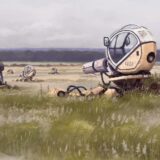I’m avoiding politics once again this time, in order to dive into the endlessly fascinating topic of human origins. And hence first, for your holiday shopping….
Can you hunt and gather and woo and connive to have the most offspring successfully reach adulthood? Only be careful competing! You only win if the the tribe survives!
Alas, folks reported interest last time… but no way to actually order the game!
Well, Steve Jackson has fixed the glitch. You can now order and play this fun diversion that’s also highly pertinent to today’s topic!
== News about human origins and evolution ==
Scientists are advancing with synthetic evolution: At 493 genes, the minimal genome of M. mycoides JCVI-syn3B is the smallest known free-living organism, artificially culled-down to the absolutely minimum number that’s viable by folks at the Craig Venter Institute. In comparison, many animal and plant genomes contain more than 20,000 genes. So far, the simplest organism would have no functional redundancies or useless spacers. Note that it requires the researchers to supply food and ideal conditions. Which leads to their next step… altering conditions to see if evolution takes place.
Spoiler alert. It does.
At the opposite end of the scale… Neanderthal genes! Was there a penalty for promiscuity around 50,000 BCE? People with roots outside Africa tend to have about 2% Neanderthal (or else Denisovan) DNA in their genome. So statistically, by random chance, you would expect Neanderthal DNA to collectively account for around 2% of the genetic risk of disease. Not in all cases, it seems: “But here we find that 8.4% is explained by Neanderthal gene flow,” much more than is expected by chance alone.”
It is so tiresome when sci journalists flub their reporting. Take these reports that the human ancestral line almost died out due to low populations about 800,000 years ago. Yes “bottlenecks” are very interesting! A recently discovered ‘y-chromosome bottleneck’ around the time of early farming towns, has huge implications! As for these news stories: yes, there was likely a time when Homo Heidelbergensis & Antecessor (ancestor of Homo Saps and Neanderthals) were a small, isolated population, and surviving that isolation helped them to thereupon differentiate and speed our evolution…
Source: CONTRARY BRIN: Human origins – and evolution. Patterns of cooperation and competition











Recent Comments